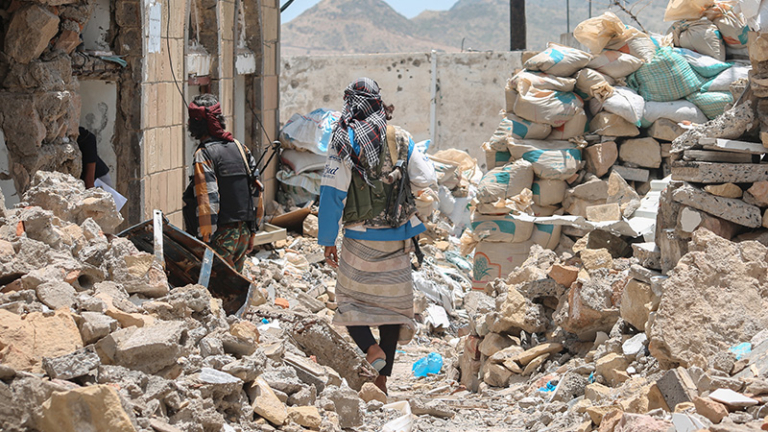
In the closing scene of the 1942 film Casablanca, Humphrey Bogart, walking off into the fog with his occasional nemesis as they plan their next move together, delivers the now classic line: “Louis, I think this is the beginning of a beautiful friendship.” The recent Saudi-Iran agreement that was brokered by Chinese officials and announced to the world on March 10 is not quite the same kind of moment, is not exactly the start of a burgeoning partnership. It does, nevertheless, represent the beginning of a new chapter in Middle East conflict and diplomacy.
In a realistic assessment of the agreement, Saudi Arabian Foreign Minister Faisal bin Farhan Al Saud emphasized that it does not signify that all disputes between the two nations have been resolved. To the extent that details on the agreement have come out, it looks more like a non-aggression pact than a detailed list of solutions to the issues and disputes that the two regional powers need to resolve in order to truly reduce tensions between them. Saudi Arabia and Iran are at loggerheads over Lebanon, Syria, Iraq, Bahrain, and, last but certainly not least, over Yemen, where competition between them has been the fiercest, and where the strategic stakes are perhaps the highest for them both, and for US foreign policy.
Immediate Implications
The presence of a signed written document between Iran and Saudi Arabia affirms the serious intent on the part of both countries to begin a new chapter in their relationship, one that is based on mutual respect for each other’s sovereignty and non-interference in each other’s internal affairs, and those of other countries. The first concrete result of the agreement will be the exchange of ambassadors for the first time since the 2016 closure of embassies in Riyadh and Tehran. References to regional tensions remained general, however, not going beyond a promise to strengthen regional peace and cooperation, based on previous agreements between the two countries in 1998 and 2001. A planned meeting between their foreign ministers is also of significance, given that the signatories to the Beijing agreement were the countries’ top security officials and not their top diplomats. And Saudi King Salman bin Abdulaziz has reportedly invited Iranian President Ebrahim Raisi to visit Riyadh.
China’s central role in sealing the Iran-Saudi deal is a definite leap in China’s global diplomacy.
Although it does not signal a takeover of the United States’ role and presence in the Middle East, China’s central role in sealing the Iran-Saudi deal is a definite leap in China’s global diplomacy, and represents a foot in the door of Mideast diplomacy. For China, which has commercial interests in both countries, brokering the accord provides further leverage on top of what was already achieved in its 2021 agreement to exchange Iranian oil for Chinese investments and its 35 new deals with Saudi Arabia, which were agreed upon during Chinese President Xi Jinping’s visit to Riyadh last December.
Consequences for Yemen
President Xi met with the chair of Yemen’s Presidential Leadership Council (PLC), Rashad al-Alimi, in December 2022, signaling China’s interest in peace efforts in Yemen, as well as in investing in Yemen’s reconstruction efforts, if and when they commence. This fits in well with China’s policy of laying the groundwork for building leverage and a future role for itself in Middle East politics. Should future Saudi-Iran talks yield an agreement on Yemen, China would have played an indirect role in achieving a peaceful end to the conflict. However, forging peace in Yemen is complicated enough for those directly involved in the process, and is unlikely to see direct Chinese involvement for the time being.
The process of achieving peace in Yemen has become more complex with the passage of time since the start of the war in 2014. The internal divisions, though caused or at least exacerbated by external influences, are complex enough on their own to endure past any potential withdrawal of foreign forces. Three main narratives surrounding the peace process in Yemen persist, each containing its own particular complications.
The internal divisions are complex enough to endure past any potential withdrawal of foreign forces.
First, the narrative of the internationally recognized government of Yemen is much the same as the one that predominated under former President Abdrabbuh Mansur Hadi, as was made apparent in the speech of the Presidential Leadership Council’s representative at the United Nations during a recent UN envoy report to the Security Council. In line with UNSC Resolution 2216, the PLC desires the restoration of the “legitimate government of Yemen” to the seat of power in Sanaa and the removal of weapons from militias, primarily from the Houthi movement, which is currently ensconced in the nation’s capital. This certainly puts the PLC at some distance from political and military realities on the ground. All indications are that the PLC was not informed of, let alone consulted on talks between Saudi Arabia and the Houthis or on the Saudi-Iran deal.
Second, the separatist Southern Transitional Council (STC), though not the only force competing for power in the south of Yemen, has become the voice of the region in internal dialogue, has closely allied itself with the UAE, and has stated its desire for independence in any future peace talks. The STC, which was critical of the Saudi-Houthi talks, has looked skeptically upon the Iran-Saudi agreement, fearing—much like PLC and the Islamist Islah Party—that the agreement might favor the Houthis and allow them to remain in control of northern Yemen.
Third, the Houthis, despite their openness to peace talks with the UN envoy Hans Grundberg, Saudi Arabia, and indirectly with the US, insist in their media and official pronouncements that their basic goal remains the “liberation” of Yemen from all foreign interference and the return to a unified state—a goal that conflicts with the PLC and the STC’s stances and their current relationships with Saudi Arabia and the UAE. The Houthis also do not shy away from reaffirming their identity as a religious party with a divine mission—a narrative that provides deep cause for concern among Yemeni forces and citizens not currently under their authority.
Issues of Immediate Concern
Even if the Iran-Saudi rapprochement succeeds in reducing tensions between Riyadh and the Houthis, conditions on the ground are bound to remain unaffected unless they are directly addressed by the Yemeni factions involved. Taiz, Hodeidah, and Marib are three areas of front line conflict between the Houthis and forces aligned against them. All three are of vital importance, and consequently are difficult for any side to give up. The city of Taiz, for example, has remained under siege by the Houthis despite numerous appeals by the Yemeni government, Riyadh, and the UN’s Grundberg, and is viewed by the Houthis as a gateway to the north that must remain closed to thwart any potential attack against Sanaa. Renewed fighting in Marib shortly followed the agreement between Riyadh and Tehran, and is a sign of concern on both sides that any rapprochement between the two regional powers might leave them in militarily vulnerable positions around the strategic city.
Beyond the active front lines lies a concern over economic and strategic lifelines that each side to the conflict is trying to secure.
Beyond the active front lines lies a concern over economic and strategic lifelines that each side to the conflict is trying to secure for an uncertain future in which a peace agreement might leave the country divided. Each side is thus looking to secure an economically and geographically viable region before it is too late. Marib and the ports of Mukalla and Hodeidah are a case in point, with the first two being vital for the production and export of oil and the latter vital for the north’s access to the sea and for importing various goods.
Meanwhile, since its initial involvement in the Yemen war, the UAE has increasingly demonstrated strategic goals that are separate from those of Saudi Arabia. For one thing, its occupation of Socotra island and its military presence on Mayoun island are testimony to its desire to control maritime assets extending from Dubai through the Red Sea and onward to North Africa. In addition, the fact that it funds, trains, and to a large extent controls forces in the south of Yemen signals an enduring interest in maintaining influence well beyond any potential peace deal in the country. Such interests and ambitions could very well cause the UAE to remain outside the Iran-Saudi agreement, at least as far as the future of Yemen is concerned.
Positive Signs
Despite all the hurdles yet to be overcome, Saudi Arabia’s hinting that it would be willing to invest in economic and commercial projects in Iran if the latter fully abides by the new agreement is definitely a sign of the seriousness of the kingdom’s interest in rapprochement with its Gulf adversary, as is the invitation by King Salman to president Raisi to visit Riyadh. In Yemen, the latest signal of a potential thaw is the recent announcement by the Houthis and the PLC of a prisoner exchange agreement that would reportedly free nearly 900 individuals currently being held by both sides. It remains to be seen, however, what Iran’s leverage is with the Houthis, and therefore what it might be able to offer in terms of Houthi concessions to Riyadh and to Yemen’s internationally recognized government. If reports on Iran’s willingness to halt arms shipments to the Houthis as part of a peace agreement are accurate, such a stance would indeed be a significant development. It might be too early to tell, however, if this is mere speculation or little more than a hint by Iran that at some point in the future, and provided that peace in Yemen seems to be progressing, it might be willing to stop at least some of its more advanced arms shipments to Yemen.
Proof of foundations for a genuine peace in Yemen remains to be seen, and much could still happen inside Yemen and in the broader region to throw even a well-intentioned peace train off its tracks. At a minimum, however, Iran could guarantee that Houthi rockets no longer attack Saudi targets, which would be enough to seal a Saudi-Houthi mutual non-aggression agreement. Such an agreement could serve as a cornerstone for a broader peace in Yemen. Alternatively, if the UAE does not cooperate and the Saudis do not push for a larger agreement, such a deal would then lead to a semi-permanent division of Yemen, with each of the multiple players securing narrow regional and/or national interests, but without guaranteeing the full benefits of peace for the people of Yemen.
The views expressed in this publication are the author’s own and do not necessarily reflect the position of Arab Center Washington DC, its staff, or its Board of Directors.
Featured image credit: Shutterstock/Akram Alrasny

